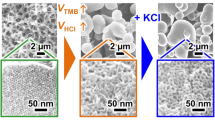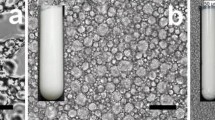Abstract
Designing low density polymeric porous materials with defined pore sizes (diameters in the 100 nm range) still remains a real synthesis challenge. Here, for the first time, we present a strategy by which bicontinuous microemulsions are used as templating agents for the in-situ aqueous polycondensation of organic resins (melamine formaldehyde, MF). The behaviour of surfactants with different head-groups in systems including oil and MF-containing aqueous phase is studied. While many surfactants are not compatible with aqueous MF precondensates, here we report a non-ionic surfactant either used solely or along with anionic surfactants which prove to be successful at keeping bicontinuous microemulsion systems homogeneous even during early stages of polymerisation. However, upon acid-catalysis it becomes clear that the pore structure of the organic material is largely controlled by the kinetics of phase separation due to the sol–gel process rather than by the thermodynamic equilibrium of the template (microemulsion). Indeed, despite numerous attempts, stabilising the microemulsion interface with zero curvature (bicontinuous) has remained problematic. Instead, we show a new behaviour for the MF resin whereby non-spherical MF morphologies (i.e. thread-like structures) can be obtained by specific interactions between the aqueous amino resin and the acid counterions.






Similar content being viewed by others
References
Payra P, Dutta PK (2003) In: Auerbach SM, Carrado KA, Dutta PK (eds) Handbook of zeolite science and technology. Marcel-Dekker, NY
Cheetham AK, Ferey G, Loiseau T (1999) Angew Chem Int Ed 38(22):3268–3292
Singh R, Dutta PK (2003) In: Auerbach SM, Carrado KA, Dutta PK (eds) Handbook of zeolite science and technology. Marcel-Dekker, NY
Yanagisawa T, Shimizu T, Kuroda K, Kato C (1990) Bull Chem Soc Japan 63(4):988–992
Kresge CT, Leonowicz ME, Roth WJ, Vartuli JC, Beck JS (1992) Nature 359:710–712
Hüsing N, Schubert U (1998) Angew Chem Int Ed 37:22
Park CB, Baldwin DF, Suh NP (1995) Polym Eng Sci 35(5):432–440
Handa YP, Zhang Z, Wong B (2001) Cell Polym 20(1):1–16
Chen SH, Chang SL, Strey R, Samseth J, Mortensen K (1991) J Phys Chem 95(19):7427–7432
Sjiiblom J, Lindbergh R, Friberg SE (1996) Adv Colloid Interface Sci 95:125–287
Gan LM, Li TD, Chew CH, Teo WK (1995) Langmuir 11:3316–3320
Gan LM, Chieng TH, Chew CH, Ng SC (1994) Langmuir 10:4022–4026
Moulik SP, Paul BK (1998) Adv Colloid Interface Sci 78:99–195
Candau F, Pabon M, Anquetil J-Y (1999) Colloids Surf A 153:47–59
Sottmann T, Lade M, Stolz M, Schömacker R (2002) Tenside Surf Det 1:20–27
Egger CC, Schädler V, Hirschinger J, Raya J, Bechinger B (2007) Macromol Chem Phys 208(21):2204–2214
Antonietti M, Henzte H-P (1996) Colloid Polym Sci 274:696–702
Hentze H-P, Kaler E (2003) Curr Opin Colloid Interface Sci 8:164–178
Liu J, Gan LM, Chew CH, Teo WK, Gan LH (1997) Langmuir 13:6421–6426
Blank WJ (1979) J Coating Technol 51:61–70
Acknowledgement
Dr Vijay Raman is gratefully acknowledged for useful discussions. Prof T. Ebbesen is warmly thanked for unlimited access to the SEM. The technical assistance from Mrs Guezide Suenaz for the mercury porosimetry is very much appreciated.
Author information
Authors and Affiliations
Corresponding author
Additional information
The work described here was carried out at BASF-ISIS, 8 allee Gaspard Monge, F-67083 Strasbourg Cedex, France.
Rights and permissions
About this article
Cite this article
Egger, C.C., du Fresne, C., Schmidt, D. et al. Design of highly porous melamine-based networks through a bicontinuous microemulsion templating strategy. J Sol-Gel Sci Technol 48, 86–94 (2008). https://doi.org/10.1007/s10971-008-1745-9
Received:
Accepted:
Published:
Issue Date:
DOI: https://doi.org/10.1007/s10971-008-1745-9




